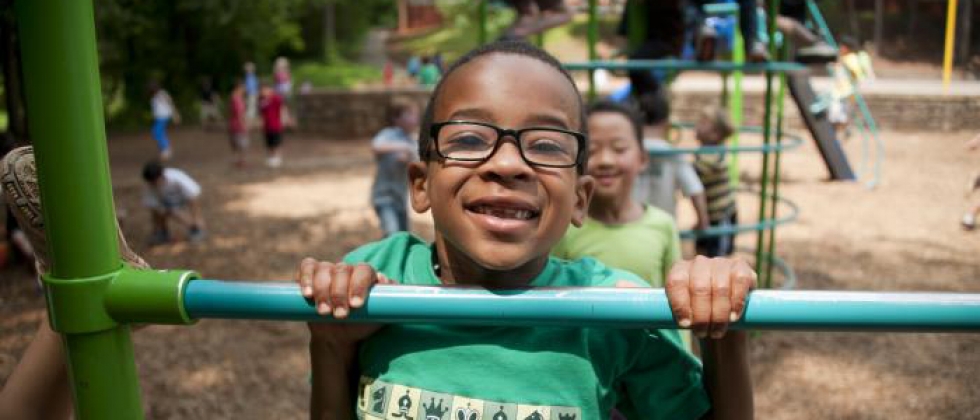What We Learned from the 2016 Legislative Session
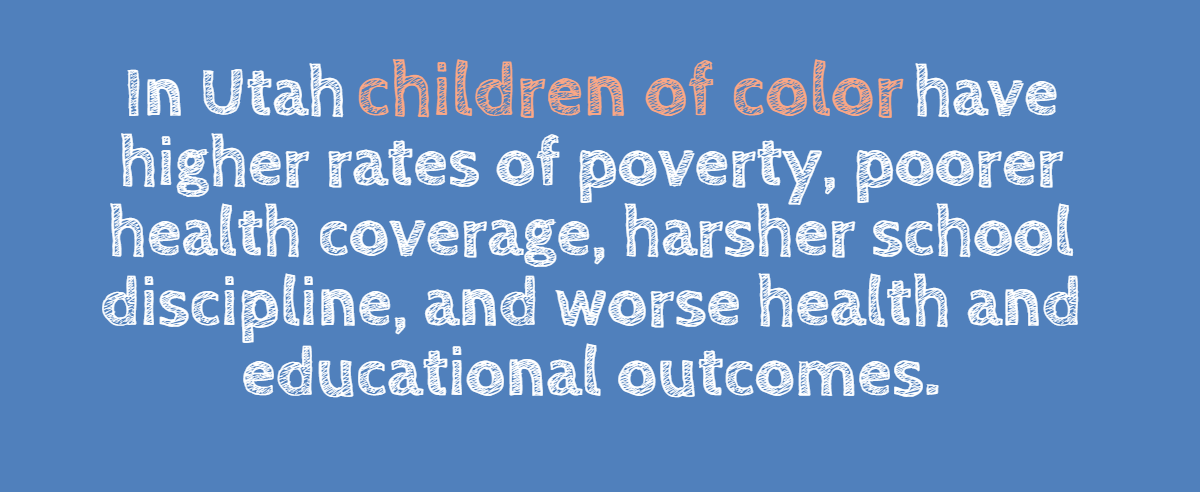
- Children of color in Utah face more poverty compared to non-Hispanic White children. As Utah becomes a more diverse state, children are affected by significant racial and ethnic disparities.
- The 2016 General Session failed to adequately meet the needs of children of color in Utah. There were some important steps forward but also missed opportunities and inaction.
- We saw gains for children’s preschool education, health coverage, school safety and criminal justice. There were missed opportunities to expand kindergarten, address our public defender crisis, expand health coverage for all low-income families and keep more families out of poverty.
- Going forward advocates have a responsibility to integrate an equity lens into our work and build coalitions that will strengthen opportunities for all families.
- Our Legislature, Governor and State Agencies should be more conscious of communities of color and low-income Utahns in their public policy decisions by reviewing the impact of bills and policies on all groups.
- In order to correct growing disparities and invest in Utah’s diverse future, lawmakers need to access data disaggregated by race and ethnicity and work with affected communities when developing policy.
Children’s Racial and Ethnic Equity in Utah
Was the 2016 Legislative Session Good for All Children?
Voices for Utah children starts with one basic question in our advocacy efforts: Is it good for kids?
For over 30 years we have been a statewide advocate, informing policymakers that they can and should act to keep children safe, healthy and help them succeed.
But as Utah’s demographic make-up changes, so too are the questions we have to ask. Is it good for all children, or just some children? Which children are making gains in our state while others are falling behind?
The number of Utah children who are non-White is growing. Since 2000, the percentage of children of color in Utah has grown from 17 to 25%. The Hispanic population is growing even faster. Hispanic children have grown from 11 to 17% of the total child population.
Unfortunately, there is a growing social and economic divide along racial and ethnic lines in Utah. Although Utah is a welcoming state, with a prominent international population, there are disparities among our diverse populations. Families of color face higher poverty rates compared to their White, non-Hispanic counterparts. The median household income for White, non-Hispanic families is significantly higher than all other racial and ethnic groups. White children are two to three times less likely to live in extreme poverty. Endnote 1
As a result, children of color have worse health outcomes, lower educational attainment, and are more likely to face school discipline and be involved in the juvenile justice system. What can we do to reverse this trend and create a Utah where all children can thrive?
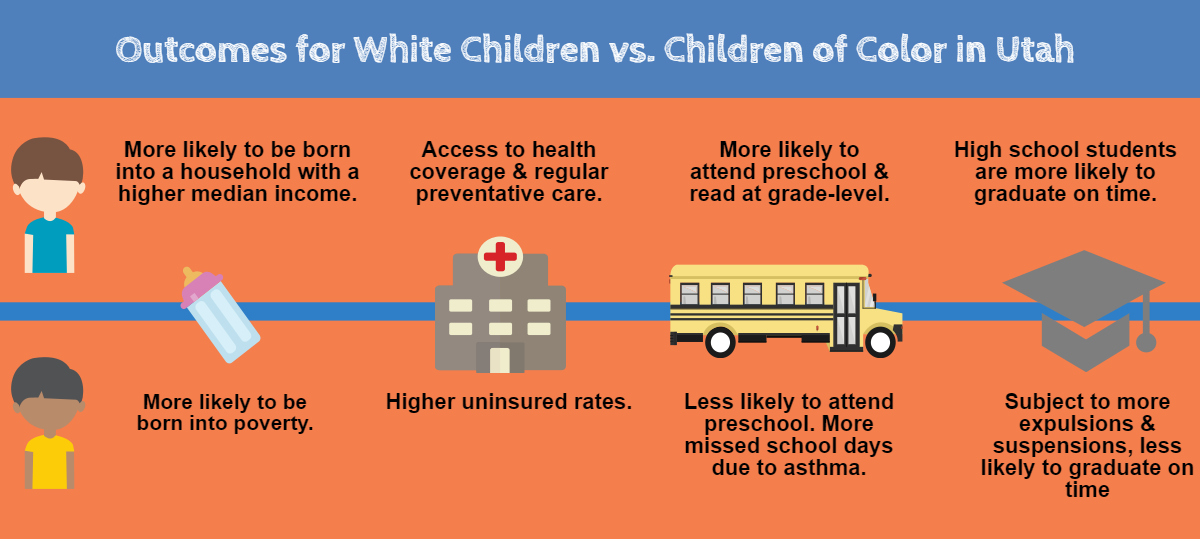
Public policies can help. Public policies play an important role in expanding opportunities for all children, strengthening our schools and public safety net. Endnote 2 But public policies can also create barriers for families. Laws can make it harder for some groups or communities to access care; funding cuts can reduce services. Or simply by maintaining the status quo, policies can perpetuate unnecessary barriers or hidden obstacles for families.
In the recent 2016 Legislative General Session, lawmakers introduced bills that expanded opportunities for children and families and others that created more barriers. At Voices for Utah Children, we look at these laws and ask not only, are they good for children? But also, are they good for everyone, or only some? And under what conditions? Endnote 3
In this report, we will reflect on the 2016 General Session and its potential impact on children from all racial and ethnic backgrounds. We examine legislation in four major issue areas: early childhood education, health, economic equity, and juvenile justice reform. Endnote 4 Using data which is disaggregated by race and ethnicity, this report will consider legislation that expands opportunity for children and youth, as well as missed opportunities for change.
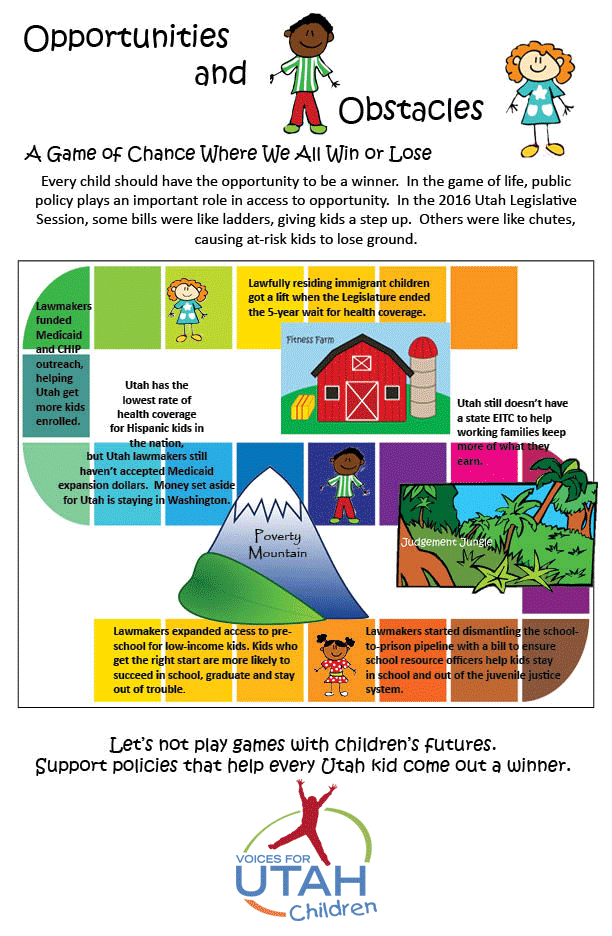
Early Childhood Education
Expanding Opportunities for High-Quality Preschool Programs
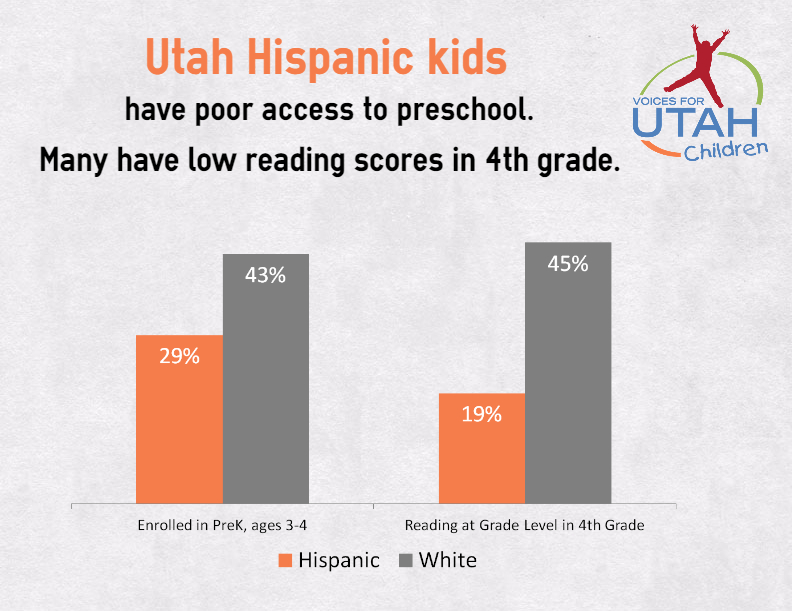
Early education opportunities can reduce racial and ethnic disparities. High-quality preschool helps children gain valuable cognitive, social, emotional and academic skills. Endnote 5 But with an attendance rate of 40%, Utah has one of the lowest rates of preschool attendance and the rate is even lower among children of color. Only 29% of Hispanic children ages 3 - 4 are attending preschool, compared to 43% of White, non-Hispanic children. One factor driving this discrepancy is that there are not enough affordable, quality preschools, especially in high-needs communities.
The Utah Legislature took steps to address this problem through SB 101, which makes more affordable, high-quality preschool slots available. SB 101 creates a grant program to expand high-quality preschool programs for at-risk children. It also provides scholarships for children who have been identified as living in intergenerational poverty. SB 101 was funded through Temporary Assistance for Needy Families (TANF), which directs funds to low-income children. However, the racial and ethnic gap in school readiness may not be fully accounted for by income, as research shows. In the future, Utah needs more programs, and supporting data, which can examine gaps in school readiness between children of different backgrounds, and ways to address those gaps in high-quality preschool programs. Endnote 6
Missed Opportunity: Expanding Optional Extended-Day Kindergarten and Readiness Assessments
 While SB 101 made significant gains for early education, the Legislature missed a critical opportunity to advance continuity in quality programming beyond preschool. HB 42 would have increased funding for quality optional extended-day kindergarten programs and created a statewide kindergarten entry and exit assessment tool.
While SB 101 made significant gains for early education, the Legislature missed a critical opportunity to advance continuity in quality programming beyond preschool. HB 42 would have increased funding for quality optional extended-day kindergarten programs and created a statewide kindergarten entry and exit assessment tool.
Full day kindergarten can help reduce racial and ethnic disparities in academic performance. In Utah, less than 15% of 5-year-olds participate in full day kindergarten programs. Endnote 7 Utah has one of the lowest rates of full day kindergarten participation in the nation. Overall there are not enough high-quality, full day, early education programs available in Utah, especially for at-risk children. This contributes to the achievement gap in later years. For example, 81% of Hispanic children are not reading at a proficient grade level by the 4th grade, compared to 55% of White, non-Hispanic children.
Moreover, Utah also lacks comprehensive data to understand children’s kindergarten readiness. By calling for a statewide entry and exit assessment tool, HB 42 would have allowed schools to better determine children’s kindergarten readiness. A statewide assessment can help educators develop appropriate interventions. Without sound, standardized statewide tools, we cannot adequately assist children most at risk of falling behind. Endnote 8
Juvenile Justice Reform
Expanding Opportunities: School Discipline and Juvenile Sentences
Nationwide, we see troubling racial and ethnic disparities in the juvenile justice system, and Utah is no exception. For example, Black children make up a disproportionate share of the juvenile justice system. Despite being only 1% of the total child population in Utah, Black youth make up 23% of the population in juvenile detention or correctional facilities.
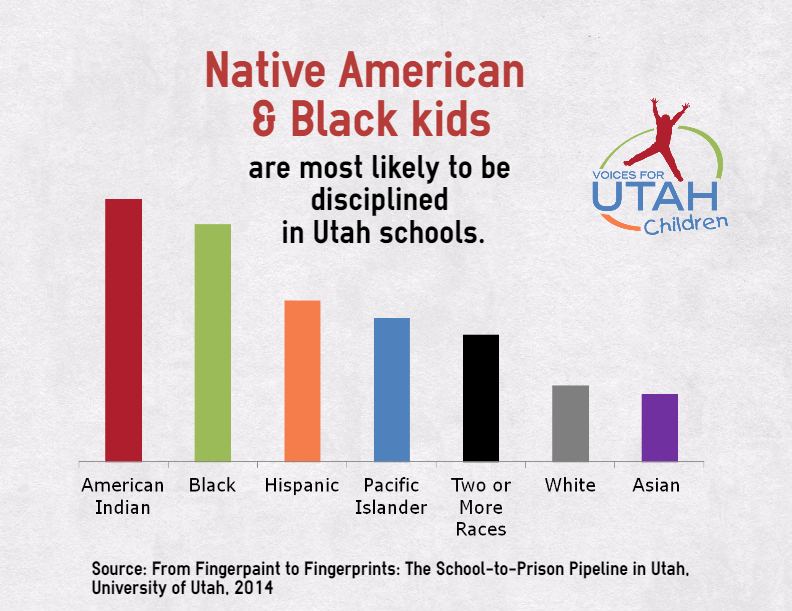
One significant factor leading to youth involvement in the juvenile justice system is school disciplinary action. There is a direct correlation between youth discipline in school and the likelihood that a child will become involved in the criminal justice system. Yet this too disproportionately impacts children along racial and ethnic lines. Children of color consistently face greater school disciplinary action compared to their White, non-Hispanic peers. Endnote 9 For example, American Indian and Black students are more likely to receive disciplinary action in Utah schools than other racial groups.
Given these findings, HB 460 is an encouraging step forward. HB 460 will provide training for school resource officers and school administrators. The law requires that the State Board of Education create a curriculum to help train officers in schools. HB 460 states that the training can include cultural awareness, resources for students exposed to trauma and restorative justice practices. Its aim is to prevent school disciplinary issues from escalating into larger, criminal justice issues. Appropriate training for school resource officers and administrators could reverse existing practices negatively affecting children of color.
Another promising step this legislative session is HB 405, which prohibits children from receiving life sentences without parole. HB 405 represents an important step in ensuring that the criminal justice system recognizes the unique needs of youth and children.
Missed Opportunities to Avoid Harsher Sentencing for Children of Color
There were also some significant missed opportunities for juvenile justice reform. In particular, SB 155 failed to address the crisis of public defenders in Utah. The law proposes to further study the problem and offers small county-level grants for adult indigent defense. While important, however, this will not help youth. All adults and children have the right to counsel if charged with a crime that might lead to jail, but Utah has failed to fulfill this Constitutional requirement. If a child does not have adequate access to a defense attorney, he or she could receive a harsher sentence. Low-income children of color are more likely to find themselves in the criminal justice system, and therefore more likely to experience harsher sentencing. The ‘school to prison pipeline’ in Utah is fueling some of our most alarming racial and ethnic inequities. We need systems committed to addressing these disparities and helping all children succeed.
Economic Equity
Missed Opportunities to Restore Funds for Public Programs
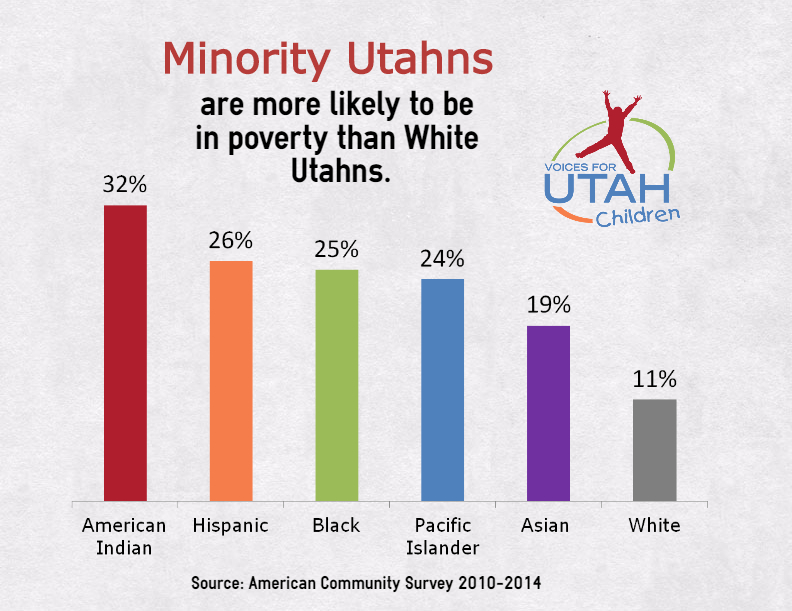
Families of color face higher poverty rates. Although Hispanic children make up only 17% of the total child population, they represent at least 39% of children living in poverty. Among Hispanic children, 31% live below the poverty threshold compared to 8% of non-Hispanic Whites. From the data available by racial and ethnic categories, we know that poverty in Utah is not experienced equally among all racial and ethnic groups.
What can our public policies do to help all Utahns? As a starting point, we need to ensure that there are enough public dollars available in our General Fund for the programs and services proven to help people achieve independence, meet their families’ needs, and move out of poverty. According to the Utah Foundation, public revenues in Utah are at a multi-decade low due to tax cuts enacted over the past decade. The 2016 Legislature failed to pass legislation that would have restored revenues. Instead, the 2016 Legislature focused its attention on several tax cutting measures, passing HB 61 to reduce corporate income taxes by about $3 million annually and coming close to passing HB 180 to expand a business sales tax exemption by $83 million annually.
Even as legislators give serious consideration to tax cuts that reduce funds available for education, health care, and initiatives that help families work their way out of poverty, the practice of earmarking – permanently diverting General Fund revenues to the Transportation Fund to avoid allowing transportation revenue sources like the gas tax to keep up with inflation – continues nearly unabated. Even though the Legislature’s own Tax Review Commission recommended eliminating almost all existing earmarks, the only proposal that passed this year was a compromise bill that restores about 4% of earmarks to the General Fund, while at the same time more deeply entrenching the earmarking phenomenon by redirecting transportation earmarks for water infrastructure instead.
Missed Opportunities to Help Utah Families Work Their Way Out of Poverty
Despite continued advocacy, there was no legislation in the 2016 session for a state-level Earned Income Tax Credit (EITC). The EITC is a policy proven to help millions of U.S. working families stay out of poverty. National data show that the EITC can help mitigate racial and ethnic disparities; almost half of all EITC-eligible households were headed by racial or ethnic minorities. Endnote 10 Families of color are more likely to be eligible for, and greatly benefit from, the EITC. A state-level tax credit for working families in Utah would keep even more families out of poverty.
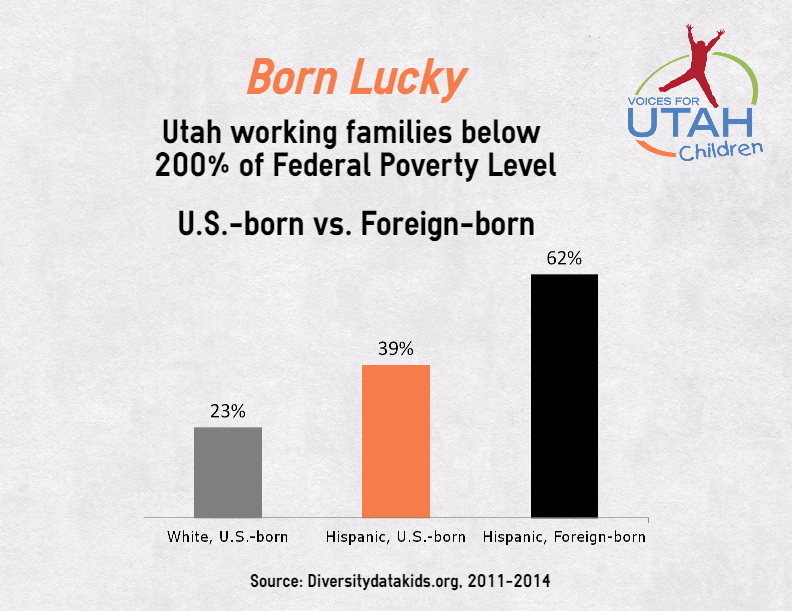 Paid leave was yet another missed opportunity to help families stay out of poverty. Many families do not have access to unpaid leave, and many who do have access are unable to afford it. The 2016 Legislature considered HB 188, which would have provided paid family leave for eligible executive branch agency employees. Families in the executive branch, which includes state divisions, departments and higher education systems, would be able to take leave, without losing pay. The topic will be further studied by the Legislature during the 2016 Interim.
Paid leave was yet another missed opportunity to help families stay out of poverty. Many families do not have access to unpaid leave, and many who do have access are unable to afford it. The 2016 Legislature considered HB 188, which would have provided paid family leave for eligible executive branch agency employees. Families in the executive branch, which includes state divisions, departments and higher education systems, would be able to take leave, without losing pay. The topic will be further studied by the Legislature during the 2016 Interim.
White, non-Hispanic parents in Utah are more likely to be eligible and financially able to take unpaid leave than other families. Discrepancies in family leave policies take the greatest toll on foreign-born parents of color: 20% of Hispanic foreign-born parents are both eligible and can afford unpaid leave, compared to 31% of White foreign-born parents. Among U.S.-born parents, 33% of Hispanic parents and 37% of White parents can afford to take unpaid leave. Endnote 11 Parents who are ineligible or cannot afford leave are at risk of losing pay--or their job-- when they stay home to care for their child.
Health
Expanded Opportunities for Children’s Coverage
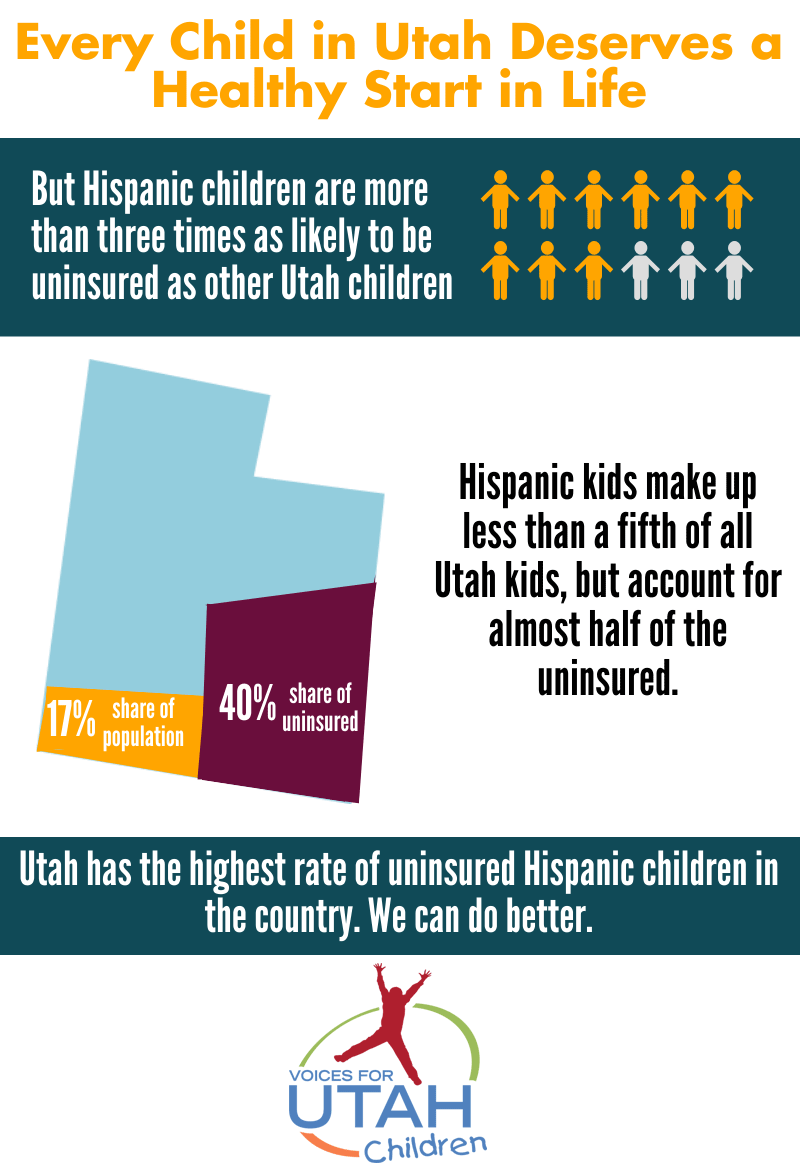
Utah has the highest rate of uninsured Hispanic children in the nation. Utah’s uninsured rate for Hispanic children is nearly two and a half times the national rate; it is higher than the rate in every other state and the District of Columbia. Children’s health coverage is the critical foundation for all children to get the care they need to achieve optimal health.
The 2016 Legislature removed the 5-year waiting period for legal immigrant children to receive CHIP or Medicaid. Appropriations bill HB 2 included intent language directing the Department of Health to enroll children as soon as they qualify. Previously, legal immigrant children were subject to a waiting period before they could receive CHIP or Medicaid. Eligible children include legal permanent residents and some additional immigration categories, although undocumented children are not included. The policy change will mean hundreds of children can get coverage. Five years is too long for children to wait.
In addition, the 2016 Legislature allocated $25,000 in one-time outreach funding to help enroll more children in CHIP or Medicaid. The Department of Health’s outreach budget was eliminated in 2010. The funding, allocated to the Department of Health, will be matched by federal dollars to total $50,000 and can be used to reach more Hispanic children.
The Legislature also directed the Department of Health to examine barriers to children’s coverage, including ‘churn’ or a frequent pattern of disenrollment and then re-enrollment from Medicaid. Children may lose Medicaid coverage because of fluctuations in their family’s income. Hispanic children are more likely to experience churn because of a change in their family’s temporary income status. At least 31% of Hispanic children have parents who lack year-round employment, compared to 18% of White children. The Department of Health’s study on churn could help reduce disruptions in children’s coverage and care.
Missed Opportunities: Expanding Coverage for All Parents
The 2016 Utah Legislature took first steps to cover more Utahns caught in the insurance coverage gap. HB 437 changed Medicaid eligibility to cover an estimated 4,000 additional parents, effectively raising the eligibility ceiling for parents with children up to 60% of the Federal Poverty Level. Unfortunately, the Legislature rejected more comprehensive bills that would fully close the coverage gap. As a result, thousands of working parents are still left without health insurance. Over one-quarter of the parents who would benefit from a full Medicaid expansion plan are Hispanic. When parents have insurance they are better able to care for their children. In addition, when parents have coverage, they bring their children along; enrollment numbers for children go up when parents have health coverage. Coverage for parents helps the whole family.
Recommendations Going Forward
Different communities may need different resources
to achieve similar outcomes.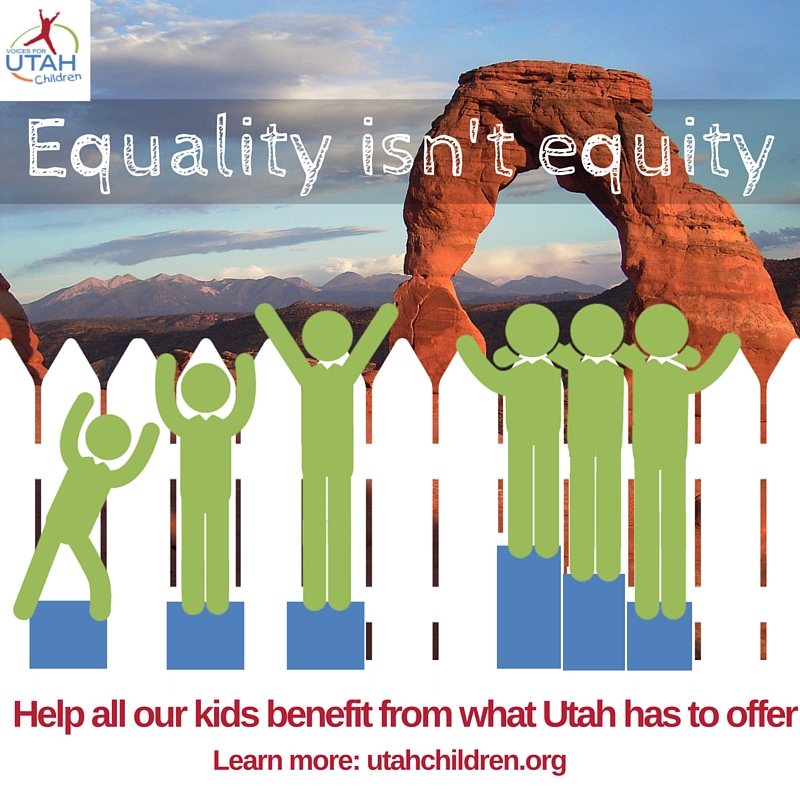
The 2016 Legislative Session expanded opportunities for some children, but there were also many missed opportunities to improve the lives of children from all racial and ethnic backgrounds. These initial steps, while important, still leave much work ahead. Endnote 12
Across every issue area reviewed, we found significant social, economic, and health disparities affecting children of color. Utah laws and policies do not adequately address the growing diversity of our state. The face of Utah’s most vulnerable is changing. We need laws that embrace our diverse future.
This report is both a reflection of our own advocacy practices, as well as a call to action for lawmakers.
As advocates, we have a responsibility to integrate a lens of racial and ethnic equity into our own work and build coalitions that will strengthen opportunities for all families.
Together with community partners, we hope to contribute to a growing dialogue about racial and ethnic equity in the coming year and to advance policies that can help reduce disparities.
Our lawmakers also have a responsibility to create a more equitable Utah. To secure a future that is safe and healthy for all children, we call on our Legislature, Governor and State Agencies to:
- Work with coalitions and affected communities.
Ensure that those most affected are actively involved in developing policies. To create sustainable solutions, families from all communities must be consulted, engaged and able to meaningfully participate in the policy process. - Collect, disaggregate and disseminate data by race and ethnicity.
Our policymakers need access to the best data and analyses. Too often population measures of children’s well-being are not disaggregated by race or ethnicity. Several state-level initiatives have already begun to make progress in this area. We need to expand these efforts so we can track progress and find solutions. Without disaggregated data, we have an incomplete picture of the needs and outcomes affecting all Utah children. - Review the racial and ethnic impact of public policies.
Our lawmakers and policymakers should review the impact of proposed policies on different racial and ethnic groups. Racial and ethnic impact assessment tools can highlight which groups benefit, and under what conditions. These targeted measures can correct disparities and help our legislators make informed decisions for all communities in Utah.
Printer-friendly version:
![]() Racial and Ethnic Equity for Children in Utah: What We Learned from the 2016 Legislative Session
Racial and Ethnic Equity for Children in Utah: What We Learned from the 2016 Legislative Session
1. Unless otherwise noted, data and indicators are from the national Kids Count Data Center: http://datacenter.kidscount.org/data#UT/2/0/char/0
2. Arkansas Advocates for Children and Families. (2015) “Missing the Mark: Race Equity and Missed Opportunity in the 2015 Session. Research Brief July 2015. Available at: http://www.aradvocates.org/publications/missing-the-mark-race-equity-and-missed-opportunities-in-the-2015-session/
3. DiversityDataKids.org. “What is Research Evidence and Why Does It Matter for Equity?” The Heller School for Social Policy and Management at Brandeis University. Available at: http://www.diversitydatakids.org/files/Policy/Head%20Start/Research%20Evidence/What%20is%20Research%20Evidence.pdf
4. Voices for Utah Children focused on these major issue areas during the 2016 Legislative Session. This report does not represent a comprehensive review of all legislation.
5. Heckman, J. J. (2011) "The American Family in Black & White: A Post-Racial Strategy for Improving Skills to Promote Equality." Daedalus, 140(2), 70-89.
6. Magnuson, K. A., & Duncan, G. J. (2005) "Can Family Socioeconomic Resources Account for Racial and Ethnic Test Score Gaps?" The future of children, 15(1), 35-54.
7. Utah Foundation. (2015) “Lessons From Our Neighbor: Learning From Colorado’s Educational Success.” Research Report 731, July 2015. Available at: http://www.utahfoundation.org/uploads/rr731.pdf
8. Utah Department of Workforce Services. (2015) “Fourth Annual Report on Intergenerational Poverty, Welfare Dependency and the Use of Public Assistance.” Utah Intergenerational Welfare Reform Commission Annual Report. Available at: https://jobs.utah.gov/edo/intergenerational/igp15.pdf
9. University of Utah S. J. Quinney College of Law. (2014) “From Fingerpaints to Fingerprints: The School-to-Prison Pipeline in Utah.” Public Policy Clinic Report. Available at: https://www.law.utah.edu/news/from-fingerpaint-to-fingerprints-the-school-to-prison-pipeline-in-utah/
10. Holt, Steve. (2006) “The Earned Income Tax Credit at 30: What We Know.” Research Brief February 2006. Washington DC: The Brookings Institution Metropolitan Policy Program. Available at: http://www.brookings.edu/research/reports/2006/02/childrenfamilies-holt
11. DiversityDataKids.org. (2014) “Working Parents Who Are Eligible For and Can Afford FMLA Unpaid Leave.” Utah Map. Available at: http://www.diversitydatakids.org/data/map/510/working-parents-who-are-eligible-for-and-can-afford-fmla-unpaid-leave-share/#loct=2&cat=28,24&tf=17
12. The following were references and models for this report: Arkansas Advocates for Children and Families. “Missing the Mark: Race Equity and Missed Opportunity in the 2015 Session.” Available at: http://www.aradvocates.org/publications/missing-the-mark-race-equity-and-missed-opportunities-in-the-2015-session/; “Facing Race: The 2015 Oregon Racial Equity Legislative Report.” Available at: https://facingraceoregondotorg.files.wordpress.com/2016/01/2015facingraceweb.pdf; “Strong Families New Mexico 2015 Legislative Report Card.” Available at: http://strongfamiliesmovement.org/nm-reportcard
For 30 years now, Voices for Utah Children has called on our state, federal and local leaders to put children’s needs first. But the work is not done. The children of 30 years ago now have children of their own. Too many of these children are growing up in poverty, without access to healthcare or quality educational opportunities.
How can you be involved?
Make a tax-deductible donation to Voices for Utah Children—or join our Network with a monthly donation of $20 or more. Network membership includes complimentary admission to Network events with food, socializing, and opportunity to meet child advocacy experts. And don't forget to join our listserv to stay informed!
We look forward to the future of Voices for Utah Children and we hope you will be a part of our next 30 years.
Special thanks to American Express for sponsoring our 30th Anniversary Year. 

